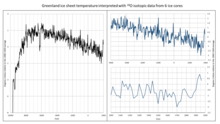Middle Bronze Age Cold Epoch
The Middle Bronze Age Cold Epoch was a period of unusually cold climate in the North Atlantic region, lasting from about 1800 BC to about 1500 BC.[1] [2] It was followed by the Bronze Age Optimum (1500—900 BC).

Greenland ice sheet temperatures interpreted with 18O isotope from 6 ice cores (Vinther, B., et al., 2009)
During that epoch, a series of severe volcanic eruptions occurred, including Mount Vesuvius (Avellino eruption, about 1660 BC),[3] Mount Aniakchak (about 1645 BC),[4] and Thera (Minoan eruption, about 1620 BC).[5]
References
- Siklosy, Z.; et al. (2007). "Middle bronze age climate change recorded in a Hungarian stalagmite: triggering by volcanic activity?" (PDF). Geophysical Research Abstracts. 11 (777).
- VINTHER, B., et al., 2009, “Holocene thinning of the Greenland ice sheet”, Nature, volume 461, (p 385-388). See: https://www.carbonbrief.org/factcheck-what-greenland-ice-cores-say-about-past-and-present-climate-change
- Vogel, J. S.; et al. (1990). "Vesuvius/Avellino, one possible source of seventeenth century BC climatic disturbances". Nature. 344 (6266): 534–537. Bibcode:1990Natur.344..534V. doi:10.1038/344534a0.
- Pearce, N. J. G., J. A. Westgate, S. J. Preece, W. J. Eastwood, and W. T. Perkins (2004). "Identification of Aniakchak (Alaska) tephra in Greenland ice core challenges the 1645 BC date for Minoan eruption of Santorini". Geochem. Geophys. Geosyst. 5 (3): Q03005. Bibcode:2004GGG.....5.3005P. doi:10.1029/2003GC000672.CS1 maint: multiple names: authors list (link)
- Friedrich, Walter L.; et al. (2006). "Santorini Eruption Radiocarbon Dated to 1627-1600 B.C.". Science. 312 (5773): 548. doi:10.1126/science.1125087. PMID 16645088.
| Preceded by |
Middle Bronze Age Cold Epoch 1800 BC– 1500 BC |
Succeeded by Bronze Age Optimum |
This article is issued from Wikipedia. The text is licensed under Creative Commons - Attribution - Sharealike. Additional terms may apply for the media files.